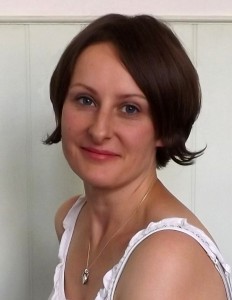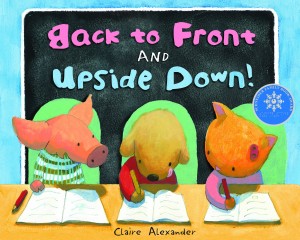 Most picture books require the efforts of both an author and an illustrator. In some instances, these talents are merged into one. I am delighted to introduce someone who wears both hats. Claire Alexander was a notable British artist before she shifted directions to become an award-winning author/illustrator.
Most picture books require the efforts of both an author and an illustrator. In some instances, these talents are merged into one. I am delighted to introduce someone who wears both hats. Claire Alexander was a notable British artist before she shifted directions to become an award-winning author/illustrator.
Welcome Claire.
In the mid 1990s, you were awarded an honors degree in painting from the Kent Institute of Art and Design in Canterbury. Since that time you have been an artist in the UK. Can you describe some of your artistic endeavors?
As well as an author and illustrator I am a portrait artist. I use oils on canvas to create often large close ups of smiling or laughing faces in bright, vibrant colours – it makes me happy! I’ve had some lovely commissions, painting adults and children. I also painted Bradley Wiggins on his bike for the Tour de France.
For the last few years, you have authored and illustrated several picture books. What prompted you to enter this field? Did your stories begin as pictures, words, or both?
I have created seven books now in all. When I first started it was definitely from the illustration angle. I attended a short illustration course in Putney, London where my nurturing tutors Carolyn Dinan and Mary Kuper encourage me to write my own book. This turned out to be Small Florence.
What challenges did you face when you first created picture books?
There were many challenges to start with. I found writing very hard and I looked to the experts for help. I studied Babette Cole’s humorous books, and other greats like Maurice Sendak, Michael Rosen, Martin Waddell and Quentin Blake to name a few. I researched and researched picture books, taking armfuls away from the children’s library before I even had my own children! I was very lucky and after around ten rejections from various London publishers I found Gullane Children’s Books and they were interested in Small Florence. I breathed a sigh of relief as I thought this was the only hurdle to jump to get published and I’d cleared it. But to my surprise I learned that publishing the title was not the editor’s sole decision, but the whole company, including sales, marketing and the foreign rights team. They all had to agree to publish the book. After then did, the next hurdle was selling the book rights internationally. UK publishers often need to do this to fund publishing in our own small market. Four years after they’d commissioned the book in 2005, enough publishers abroad had bought the rights to finally enable publishing here in 2009! In 2006 Gullane commissioned Lucy and the Bully which had a shorter procurement time of two years, meaning it actually came out the year before Small Florence! If you want to be a writer or illustrator, patience is a virtue!
You are indeed a rarity. Most authors are unable to illustrate their books and need to rely on others people’s artistic talents. Was it difficult to find publishers that would allow you to be both an illustrator and an author?
I haven’t come across this difficulty. I think publishers like working with author / illustrators. It makes their life a little easier only dealing with one person instead of two, who may have conflicting ideas about their book.
Many authors use parts of their lives as templates for their stories. Do any of your books mirror real life characters or events?
Yes! My first books were inspired by emotions I experienced growing up. I didn’t find my feet in this career and use my artistic talents fully until I was 30. Small Florence was a kind of reflection of how I’d lacked the confidence to feel I could make a living doing the thing I love. Lucy and the Bully came about because I was bullied at school when I was 11-12. I was very frightened of the girl until I saw how her badly her mother treated her. From then on I felt sorry for her and it completely dispelled the grip of fear she’d had over me and the bullying stopped.
All of your picture books use animals for characters. Do you feel that your young audience can relate better to this genre?
I do feel children relate very well to animals, but I also think they relate just as well to human characters – it’s just that I’ve not found a successful way of illustrating them yet! It’s something I’d like to do in the future.
Your first book, Lucy and the Bully, focuses on the unsettling topic of bullying. Why did you choose this subject? What type of feedback have you received from parents, teachers, and/or children?
I chose this subject because I’d experienced bullying and I wanted to be able to help children question and understand why someone might become a bully and that way they might be able to empathise and overcome their fear like I did. I’ve had very positive feed-back from teachers and children who use the book in their classrooms in the UK and the US. I once entered a classroom to find a beautiful display of children’s drawings of characters in the book and snippets of text they had written about bulling. I was so pleased as it showed they’d had an in-depth discussion about the feelings and motivations of the characters.
Another book, Back to Front and Upside Down showcases some of the frustrations associated with learning how to write. What do you hope your readers will gain from this touching story?
I hope that it says to children that it’s OK to ask for help. I wasn’t a great academic at school and had undiagnosed dyslexia which meant I always felt like I was stupid at school when I was slower than others or got things consistently wrong. I felt I was the only one in the class, but I’m sure there must have been others who felt the same; it just wasn’t talked about then.
Most learning environments involve a reciprocal relationship. Students learn from their teachers while teachers simultaneously learn from their students. After teaching numerous writing and illustrating workshops, can you share 2 things that you have learned from your students?
I love teaching and I’m constantly inspired by the talent and determination of my students. I’m always learning from them. I like it when someone brings in a book I’ve not seen before or when they tell me about a website or an illustration tool or u tube clip they’ve discovered.
Claire, is there anything else that you would like to share with my audience?
I have just finished my second book with Egmont (Monkey and the Little One, publishing spring 2015) and I’ve started on a new one which is in early stages so I’d better not say too much, only that it will come out in 2016!
If you believe in what you are doing, don’t give up. If you’ve had some positive feedback you are doing something right and it’s probably only a matter of plugging away, contacting publishers and getting seen. Determination is half of the game!
Book Giveaway
Leave a comment on this blog by November 16, 2014 and be eligible for a book giveaway. One lucky winner will be sent a copy of Back to Front and Upside Down from the publisher.
Claire’s Books
Monkey and the Little One (Due 2015)
Millie Shares 2014
That’s When I Knew 2014
Back to Front and Upside Down 2012
- 2013 US Schneider Family Book Award for the depiction of disability in a picture book
- 2013 US Paterson Prize for continued excellence
Lost in the Snow 2010
Small Florence 2009
- Shortlisted 2010 Mad About Books Stockport Schools’ Book Award
Lucy and the Bully 2008
- 2009 US Paterson Prize for Books for Young People
In exchange for an interview and honest review, I received a copy of Back to Front and Upside Down.
Related Blogs
Sandra’s Bio

Leave a Reply
You must be logged in to post a comment.